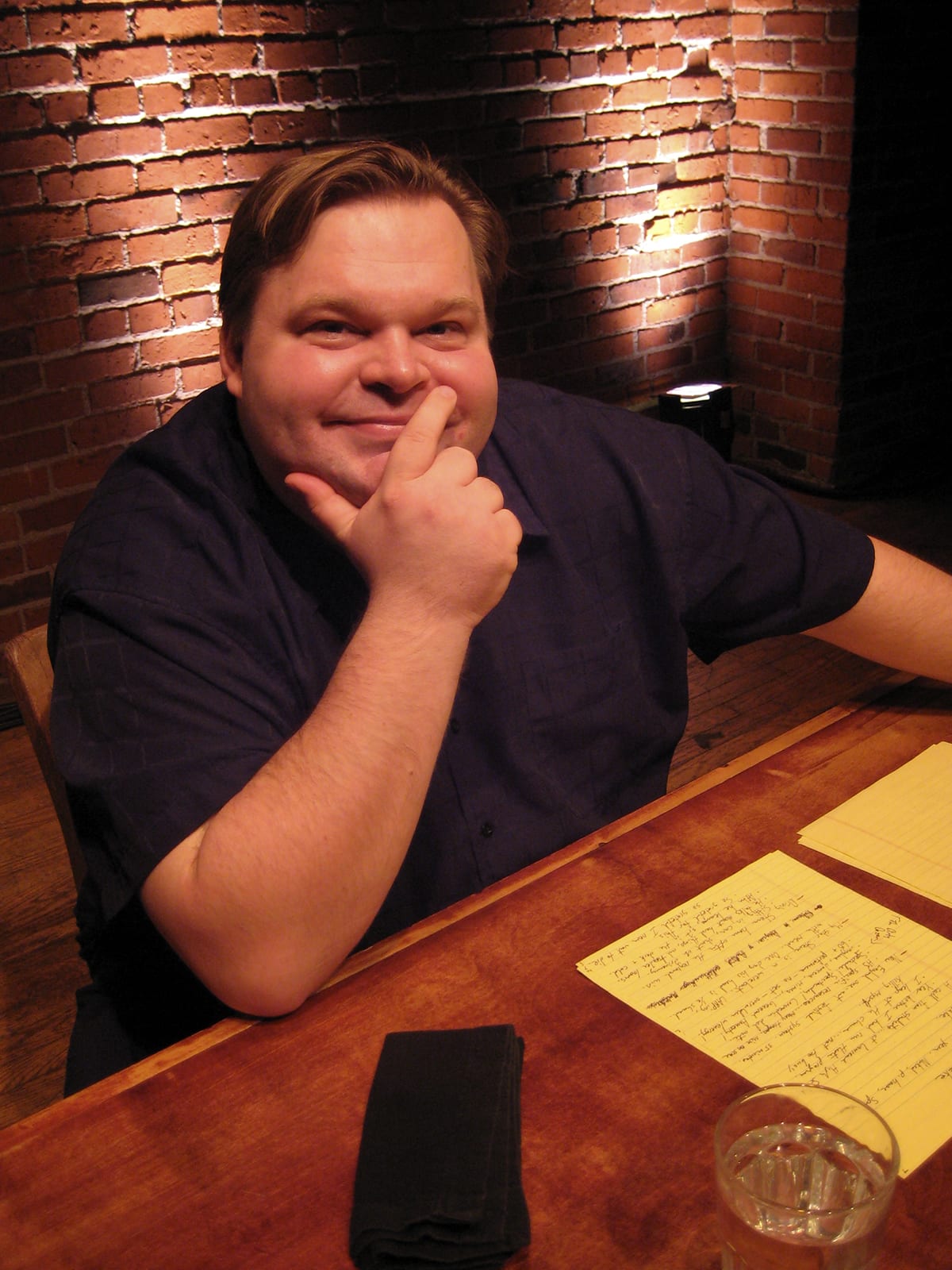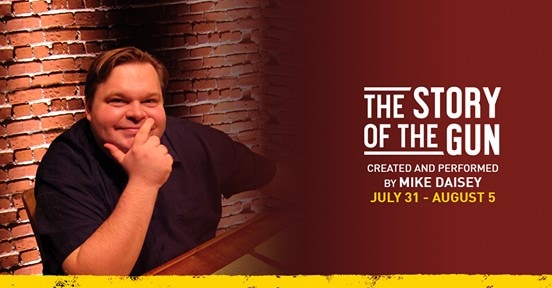Masterful monologuist Mike Daisey returns to DC to skewer with humor another burning issue of the day. This time it’s America’s thing about guns. What’s that all about, anyway? How did guns get to be more American than apple pie? The show is called The Story of the Gun, and it offers some surprising answers.
The Story of the Gun plays one week only at Woolly Mammoth Theatre Company July 31 to August 9. Daisey’s fans will know better than to miss it. And newbies will be in for a scintillating eyeopener.

Daisy is a regular raconteur on the Woolly stage. Over the years, I’ve relished six of his shows there: How Theater Failed America (2009), The Last Cargo Cult (2010), The Orient Express (Or, the Value of Failure) (2012), The Agony and Ecstasy of Steve Jobs (2012), American Utopias (2013), and The Trump Card (which ran Cassandra-like a week before the 2016 election).
Daisey, who creates and performs all his own material, typically sits at a table with pages of notes and a glass of water before him and regales us with stories. And before we know it, he has us laughing and aghast.
John: DC audiences obviously really like you. What do you like about DC audiences?
Mike: Well, there’s real strength to being in a center of power. I’ve always treasured the ability to talk to real American citizens. The humanity we’re always most in touch with is our own, and there’s real power in being able to have a human conversation that isn’t mediated by the media just steps away from where the corridors of power really are, the levers that cause the largest things to move in our world, which is the machinery of the capital. I really love that about coming to DC.
In the run-up to the 2016 election, you brought The Trump Card to DC, and we talked then about how the show had changed as more and more damaging stuff came out about the candidate. Since Trump won, you’ve done at least two shows related to his presidency, This Is Not Normal and The End of Journalism.
Yeah, both of those are certainly post-Trump shows. The concerns of The End of Journalism are larger than the Trump presidency, but that show is definitely heightened and underlined by the disaster currently unfolding. This spring at the Guthrie, I performed the 18-part A People’s History, which attempts to contextualize our current moment by looking at the whole of our history. I haven’t done any work in the last 18 months that’s not either directly related to the current crisis or strongly impacted by it.
What have you learned since the election that you didn’t know when you did The Trump Card?
I didn’t know how terrible it was going to be in its particulars, and so I sit, like most people do, in a state of expanding, ongoing horror. I’ve spent a lot of time wrestling with the psychological implications of unending torment. As terrible news compounds on top of terrible news, a lot of how one reacts to the ongoing situation becomes: how do you handle the news when the news is always terrible and often more terrible than you had contemplated actually happening?
A lot of the reactions that normal human beings have to that—to become numb, to attempt to normalize things—are actions that reinforce abuse of power. My own reactions have been mapped very closely to that. I feel myself normalizing things that are terrible. You want to stay outraged at the things that deserve outrage. At the same time, if you are outraged every single day at the highest intensity, you will burn yourself out. And if you burn yourself out, then you won’t be there to actually fight. It’s very difficult to manage at times like this.
You’ve been performing The Story of the Gun for about four years?
It was first performed in early 2013. The show was commissioned and created in response to Sandy Hook—which is indicative of how sad the entrenched state of the gun conversation is that that shooting has now become like fabled, old history. Joe Haj, who was then artistic director at PlayMakers in North Carolina and is now artistic director at the Guthrie, approached me to ask if I’d be interested in trying to tackle the gun conversation in a new way. I said that I was, and that’s how the show began.
How has The Story of the Gun changed since then?
It’s deepened. I wanted to have a conversation about guns that blocked out everything that was contested territory. The show is an attempt to talk about guns without using the language of either gun-control advocates or gun-rights advocates. I simply tried to exclude all that from the conversation to then see what was left, which is one of the ways the show found its form: I realized one of the central questions that neither side really deals with is the actual history of guns.
You have this thing that’s such a divided issue for a huge number of people in the country, but the actual history of how guns came to occupy this psychic space in America is never part of that conversation. The conversation always revolves around very limited talking points about shootings and reactions to shootings, and it’s never about why our country’s statistics are wildly different than everyone else’s. When did they start diverging? How did this begin? What is the evolutionary path that led us to this moment? By exploring that, I discovered there were some very useful things one can say about guns in America that don’t directly contradict either side’s orthodoxy and that make it then worth talking about.
Is it fair to say audiences coming to The Story of the Gun who think they know what you’re going to say will be surprised?
Yes, I think that’s true. If they weren’t, then that would be bad, because no one’s interested in a conversation about hot-button issues if you’re not able to find a new, compelling, empathic angle. It’s already a problem where the soil has become so drained of nutrients that new actual thought can’t grow there.
It makes complete sense that we have an intractable problem with guns if you go back and actually examine the fact that this country was founded at the point of a gun and absolutely implemented by guns. America the experiment is absolutely impossible except for guns. The discovery of the New World and the bringing over here of guns, which was new technology at that moment—the existence of guns at that moment allowed a technological superiority to aid and abet the genocide of a huge number of people.
And it’s the gun that underlies that power. It’s the gun that gives early settlers and colonists, after they establish a foothold, the power to bring people over as slaves. Without guns, they would not have been able to enforce slavery the way that they did. Guns are integral to the entire American experience. As a consequence, you can’t extract the gun from the country that was created by it.
Recently the story of Trump and the story of the NRA converged in revelations about Russian influence on American politics. Did you see that coming?
Well, I don’t know that I saw it coming, but it’s clear now. The counter-intel that Russia has been doing on American politics has succeeded beyond their wildest expectations. And one of the largest levers to manipulate is the lobby of gun ownership, because it reaches a very specific demographic slice across America. That is a powerful tool to wield. If you can manipulate that group, you’re manipulating a huge number of American voters. So it makes sense to me that the Russians would.
I know you think a lot about the role of the theater artist in relation to social justice. What are your personal guiding principles about that?
As a younger person, I would often get distracted and disheartened because I would wish that the things I was creating in the theater, the things I was seeing in the theater, would reach beyond the theater. And that has always given me a kind of ambition. As I’ve gotten older, I’ve learned to temper that with the wisdom to see that it is not just the amount of people you reach, it’s the depth to which you reach them.
In a world where anyone can record a YouTube video and post it, you can have a viral impact on a tremendous number of people. The question becomes: to what depth were you able to have that impact, and how complex was the conversation you were really able to have in that medium?
One of the things that theater does better than any other art form is human connection, because the artist is actually present, sculpting the work in the moment. I treasure my form of theater because I am present and the words themselves shape to the moment that they’re spoken. In the same way, this conversation is shaped by the questions you’re asking, the experience in the theater is shaped through the concerns of the present moment.
I know that the show I’ll be performing next week will be highly influenced by everything that’s happened with the Trump presidency. And then in the moment when I speak the words and I sculpt them, they will be informed by those things, and they’ll be formed by the people in the room, and so we will be in communion in that space. That kind of conversation, that kind of deep communion, is largely absent from our civic discourse now. But we need community very badly.
I see my job through the theater as a way to create an intentional community, and an attempt each time for those who choose to participate in it to have a very real conversation that begins germinating in the room. But that’s just the seed that I am planting with them; the real flowering of it is outside the room. The people in the room with me who have this conversation about the nature of guns, of violence, of male aggression and the history that lends itself to through the American experience—they’ll carry that conversation out of the room with them.
As a young man, I used to take too much on myself. I would think, “I have to find a way to not only do this live in the theater; I’ve got to find a way to bring it to all these people.” But at the end of the day, I don’t bring it to the people. The people receive it, it comes through me, and they are the ones that go out into the world just as each of us goes out every day, and they’re the ones that have to be the change they want to see. You just hope that your work inspires that.
Read my column about the show.
The Story of the Gun plays July 31 through August 9, 2018, at Woolly Mammoth Theatre Company – 641 D Street, NW, in Washington, DC. For tickets, call the box office at (202) 393-3939, or purchase them online.





